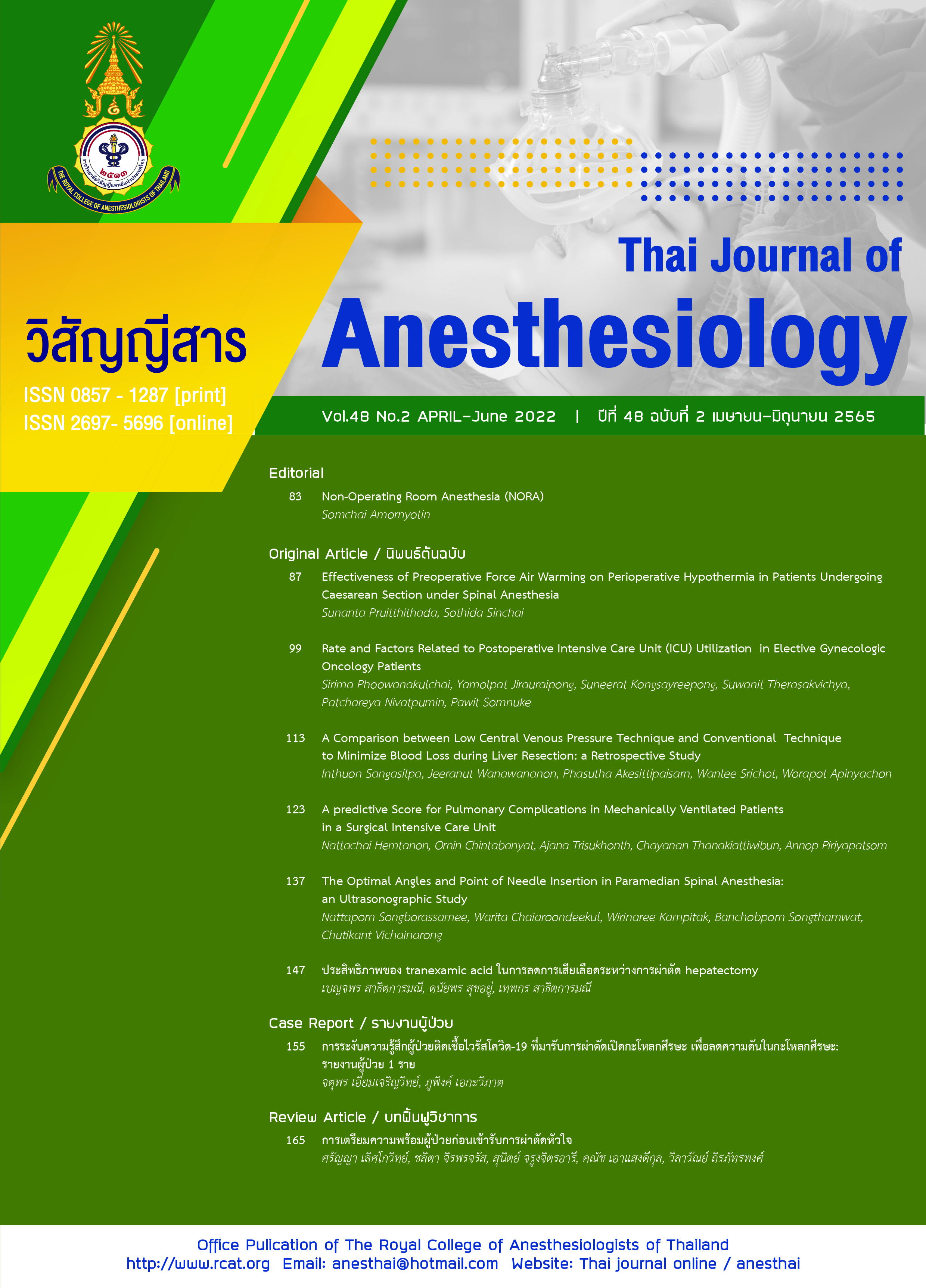Effectiveness of Preoperative Force Air Warming on Perioperative Hypothermia in Patients Undergoing Caesarean Section under Spinal Anesthesia
Main Article Content
Abstract
Background: The incidence of inadvertent perioperative hypothermia (IPH) in Ramathibodi Hospital between 2018 and 2019. Studies evaluating the effectiveness of preoperative warming (prewarming) in preventing IPH are controversial. Especially, its effects on pregnant women undergoing cesarean section under spinal anesthesia (SB). This study aimed to assess whether the prewarming with force air warming (FAW) can prevent IPH or shivering in patients undergoing cesarean section under SB. Methods: This prospective randomized controlled trial was performed on 44 term-pregnant women, which scheduled for elective cesarean section under SB. Subjects were randomly assigned to either control or prewarming group. The prewarming group received at least 10 min of prewarming with FAW set to 38oC, whereas the control group received standard usual care without prewarming. Using intention-to-treat analysis, the primary outcome was the change in tympanic temperature. The secondary outcome was the incidence of shivering at post-anesthetic care unit (PACU). Results: There was a continuous decline in the tympanic temperature after SB in both groups. Using ANCOVA adjusted for baseline, the result did not differ significantly at any time point (P=0.939). Although the prewarming group had a higher temperature prior to SB than control group (36.50±0.31 vs 36.64±0.33, P=0.007), there was no difference in the incidence of hypothermia on arrival at the PACU between the groups (P=0.531). Shivering occurred similarly in the two groups (3 (13.64%) vs 1 (4.55%) patient for the control and prewarming group, respectively; P=0.613). Conclusion: A brief 10-min of prewarming set at a moderate 38oC temperature did not prevent inadvertent perioperative maternal hypothermia and shivering. For better thermal benefits, longer period and higher temperature setting of prewarming may be considered.
Article Details

This work is licensed under a Creative Commons Attribution-NonCommercial-NoDerivatives 4.0 International License.
References
NICE. Inadvertent perioperative hypothermia: The management of inadvertent perioperative hypothermia in adults. NICE Clinical Guideline No. 65.: NICE. 2008. [Last accessed on 02-10-2019]. Available from http://www.nice.org.uk/guidance/cg65.
Sessler DI. Perioperative thermoregulation and heat balance. Lancet. 2016;387:2655-64.
Frank SM, Fleisher LA, Breslow MJ, et al. Perioperative maintenance of normothermia reduces the incidence of morbid cardiac events. JAMA. 1997;277:1127-34.
Kiekkas P, Poulopoulou M, Papahatzi A, Souleles P. Effect of hypothermia and shivering on standard PACU monitoring of patient. AAAN J. 2005;73:47-53.
Kurz A, Sessler DI, Lenhardt R. Perioperative normothermia to reduce the incidence of surgical-wound infection and shorten hospitalization. Study of Wound Infection and Temperature Group. NEJM. 1996;334:1209-15.
Lenhardt R, Marker E, Goll V, et al. Mild intraoperative hypothermia prolongs postanesthetic recovery. Anesthesiology. 1997;87:1318-23.
Leslie K, Sessler DI, Bjorksten AR, et al. Mild hypothermia alters propofol pharmacokinetics and increases the duration of action of atracurium. Anesth Analg. 1995;80:1007-14.
Rajagopalan S, Mascha E, Na J, Sessler DI. The effects of mild perioperative hypothermia on blood loss and transfusion requirement. Anesthesiology. 2008;108:71-7.
Schmied H, Kurz A, Sessler DI, et al. Mild hypothermia increases blood loss and transfusion requirements during total hip arthroplasty. Lancet. 1996;347:289-92.
Frank SM, El-Rahmany HK, Cattaneo CG, Barnes RA. Predictors of hypothermia during spinal
anesthesia. Anesthesiology. 2000;92:1330-4.
Hui CK, Huang CH, Lin CJ et al. A randomised double-blind controlled study evaluating the hypothermic effect of 150 micrograms morphine during spinal anaesthesia for Caesarean section. Anaesthesia. 2006;61:29-31.
World Health Organization. Global guidelines for the prevention of surgical site infection. WHO 2016. [Last accessed on 02-10-2019]. Available from https://apps.who.int/iris/bitstream/handle/10665/250680/9789241549882-eng.pdf
Hynson JM, Sessler DI, Moayeri A, et al. The effects of pre-induction warming on temperature and blood pressure during propofol/nitrous oxide anesthesia. Anesthesiology. 1993;79:219-28.
Glosten B, Hynson J, Sessler DI, McGuire J. Preanesthetic skin-surface warming reduces redistribution hypothermia caused by epidural block. Anesth Analg. 1993;77:488-93.
Horn EP, Bein B, Böhm R, Steinfath M, Sahili N, Höcker J. The effect of short time periods of pre-operative warming in the prevention of peri-operative hypothermia. Anaesthesia. 2012;67:612-7.
Olson DM, Grissom JL, Williamson RA, Bennett SN, Bellows ST, James ML. Interrater reliability of the bedside shivering assessment scale. Am J Crit Care. 2013;22:70-5.
Chung SH, Lee BS, Yang HJ, et al. Effect of preoperative warming during cesarean section under spinal anesthesia. Korean J Anesthesiol. 2012;62:454-60.
Moran JL, Peter JV, Solomon PJ, et al. Tympanic temperature measurements: Are they reliable in the critically ill? A clinical study of measures of agreement. Crit Care Med. 2007;35:155-64.
Jun JH, Chung MH, Kim EM, et al. Effect of pre-warming on perioperative hypothermia during holmium laser enucleation of the prostate under spinal anesthesia: a prospective randomized controlled trial. BMC Anesthesiol. 2018;18:201.
Szmuk P, Ezri T, Sessler DI, Stein A, Geva D. Spinal anesthesia speeds active postoperative rewarming. Anesthesiology. 1997;87:1050-4.


